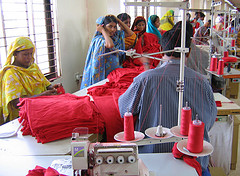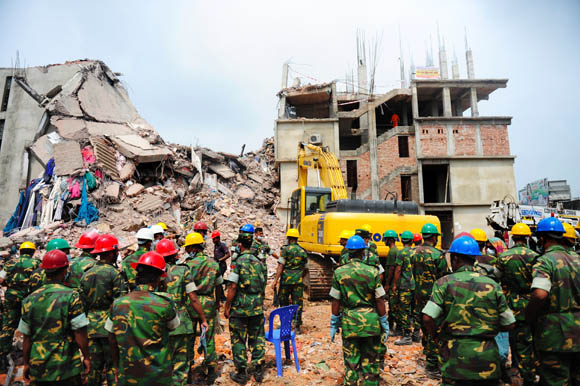
We aren’t accustomed to thinking of sewing as a death-defying trade, but as Hillman Judge Harold Meyerson explains in the Washington Post, garment workers in Bangladesh take their lives in their hands each day when they report to poorly built factories to stich cheap clothing for Western consumers.
On April 24, the Rana Plaza factory complex collapsed, killing over 1100 workers, but the Rana disaster was just the best known of a string of entirely preventable mass casualties. In the weeks since the collapse several fires have swept through garment factories in Bangladesh, the most recent of which killed eight people:
“That fire began on the lower floors, but people died on the floors above,” says Scott Nova, who heads the Workers Rights Consortium, the organization that has spearheaded the global fight to make garment factories safe. “Those people would have had no trouble getting out unharmed if they could have walked into stairwells protected by fire doors. But the factory had open staircases that became a chimney, funneling toxic smoke to the upper floors. And most of the factories in the country are similarly structured.” [WaPo]
These deaths reveal the inadequacy of the current regime of voluntary factory inspections that many Western companies use to put a figleaf on dismal working conditions. After Rana companies protested that their inspectors weren’t sent to inspect the physical integrity of the structure. Well, it doesn’t take a civil engineer to notice that a stairwell has no fire doors.
But there is cause for optimism. Rana may finally have shaken Western brands–and the Western consumers who buy their products–out of their complacency:
In the wake of Rana, that’s begun to change. Under pressure from unions and anti-sweatshop activists in their home countries, the European retailers and brands with the biggest presence in Bangladesh agreed this week to a plan under which they would pay for renovations to make their factories safe and independent inspections that would keep them that way. The retailers include H&M, which is the biggest buyer in Bangladesh, Carrefour and the British-based firms Tesco and Primark.
Thus far, most U.S. firms have declined to sign on. Holdouts include Wal-Mart, which ranks just behind H&M in the volume of clothing produced in Bangladesh; Gap; JC Penney and Sears. The only U.S. company to join the accord — and it signed on to a version that predated last month’s disaster outside the Bangladeshi capital — is PVH, the parent company of Tommy Hilfiger, Calvin Klein and Izod. [WaPo]
PVH had an extra push to do the right thing. The company decided to clean up its act after 2013 Hillman Prize-winner Brian Ross and his team at ABC News publicly shamed Tommy Hilfiger over factory deaths in Bangladesh in 2012.
[Photo credit: jankie, Creative Commons.]









